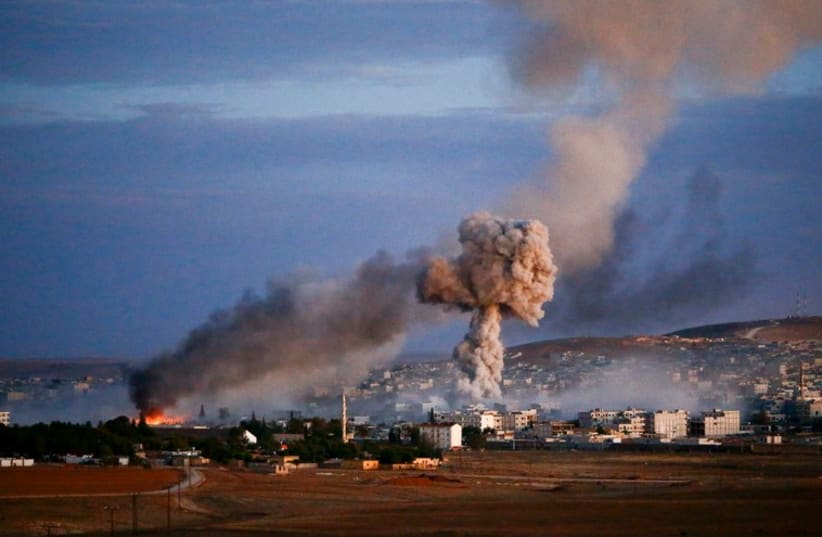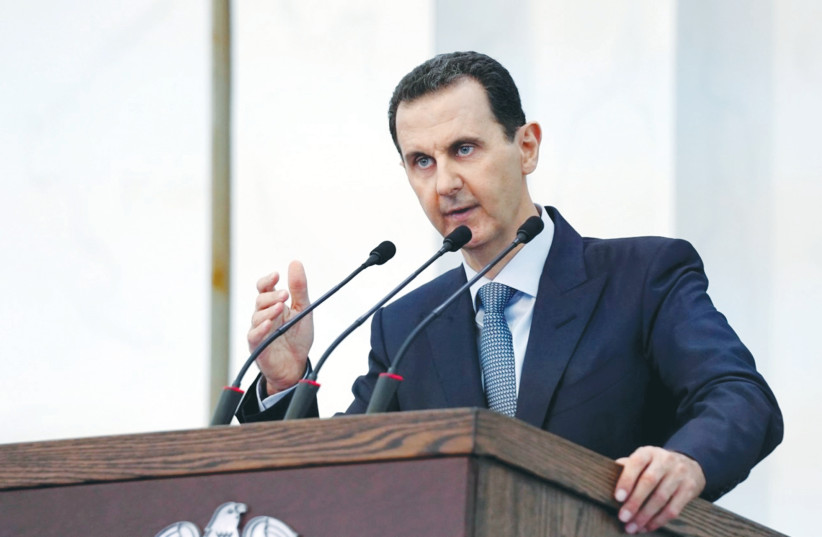Overnight between February 22 and 23, a missile strike was reported in Syria. According to reports in foreign media, the strikes hit two areas near the Golan Heights. The Alma Research and Education Center, which publishes expert analysis on challenges in Israel’s North relating to Syria and Lebanon, put up a tweet about the incident.
The center asks whether the type of missiles used overnight to strike at targets of Hezbollah’s Southern Command were the same type used during a previous attack on February 17, when elements of the Syrian Army 7th division were hit south of Damascus.
This matters because back in January, reports said that Russia and Syria had conducted a joint air patrol near the Golan. The Syrian regime reconquered areas near the Golan in 2018 and largely defeated Syrian rebel units near Israel’s border that year. The area has remained restive, and Hezbollah and Iran have exploited this fact by sending teams closer to the Golan. Russia plays a key role in southern Syria and this makes for a complex environment.
Understanding the complexity of southern Syria and Israel’s concerns about Iranian entrenchment is also key to understanding both Israel-Russia ties and also the tensions in Ukraine. This is because back in 2015 when Russia entered the Syrian war with increased airpower sent to Syria, Israel’s then prime minister Benjamin Netanyahu went to Russia to meet President Vladimir Putin that September. Reports at the time said Russia and Israel would coordinate military action in Syria. A joint mechanism to prevent misunderstandings was set up, a kind of de-confliction mechanism.
BUT THINGS have changed since 2015. In those days, the Syrian regime was weak and looked like it might fall. Over time it was able to reconquer large parts of Syria with Russian and Iranian backing. But Moscow and Tehran have different agendas in Syria. Russia wants a stable Syrian regime; Iran wants to exploit the regime's weakness to carve out areas for Iranian bases and trafficking of weapons, much as it has done in Iraq, Lebanon and Yemen.
Iran wants the Assad regime in power, but prefers that it can use the countryside of Syria to attack Israel and to run drugs and do other activities. The Islamic Republic has moved drones to Syria to threaten Israel and the US, it has also tried to move air defense systems and sent a Hezbollah drone team to an area near the Golan in 2019.
Read more on the Ukraine-Russia War:
- Israelis in Ukraine told to evacuate, Israeli diplomats to help
- Rabbis stay in Ukraine to support Jewish community
- Guterres to Putin: 'In the name of humanity stop this war against Ukraine'
- How war in Ukraine increases Iran’s threat against Israel - analysis
Other incidents have created controversy between Israel and Russia in Syria. In 2018, Syrian air defense shot down a Russian plane over Latakia during an Israeli airstrike. Israel made amends but tensions have continued. In 2019, Russia made light of Israeli airstrikes in Syria and said Israel had flown over Jordan to conduct strikes. By 2021, mixed reports appeared about whether Russia might hamper Israel’s air campaign in Syria. This campaign is often referred to as the “campaign between the wars.”
Meanwhile, Iran is seeking to continue building its network in Syria, what is called the “land bridge” to Lebanon from Iran via Iraq. In May 2021, Iran flew a drone from Iraq over Syria into Israeli airspace. Hezbollah also recently said it flew a drone into Israeli airspace.
Israel could set up a regional counter-drone partnership with other countries being threatened by drones; US NAVCENT, the Naval part of Central Command, wants to increase use of unmanned systems in the region. Taken together, what we know is that Israel is close to its Gulf partners and the US, but that Syria is a huge issue for the Jewish state.
THE OVERALL trend in Syria is unclear. Iran continues to threaten Israel. Airstrikes reported in foreign media appear to show that Iran and Hezbollah are continuing to build up dangerous sites in Syria that threaten the region. They also threaten US forces at Tanf Garrison near the Jordan border.
Israel has to weigh all this in deciding how it responds to the Ukraine crisis. This is because regarding big, global issues, Jerusalem would normally side with the US and Western partners. But Israel must weigh Russia’s responses and what it means for Syria policy.
Iran is already angling for a new nuclear deal and also for deals with Qatar. Turkey has condemned Russia’s new statements on Ukraine, but Moscow has said it understands Ankara's position. It is unclear if Russia would be less enthusiastic about a similar statement from Israel.
Overall, the Ukraine issue is just one of many question marks about Israel-Russia ties. Jerusalem also had to walk a thin line regarding US concerns about Israel-China ties in the past. This is because Israel’s overall position in the world is a country between East and West, which matters as fortunes change in global affairs and global economies.
The immediate issue for Israel, however, is Iran’s role in Syria and also the Hezbollah threat. Making sure relations with Russia continue as they have is important. The recent strike in Syria, reportedly by a missile against a Hezbollah site, illustrates the importance and sensitivity involved. Also, using surface-to-surface missiles is preferable to using piloted aircraft, because of the issues involved in Syria today.

